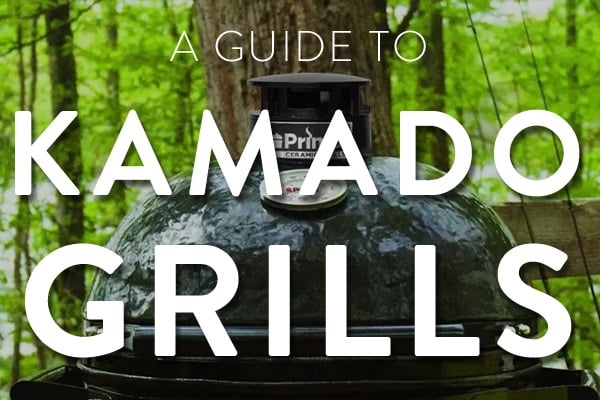
A Guide To
Kamado Grills
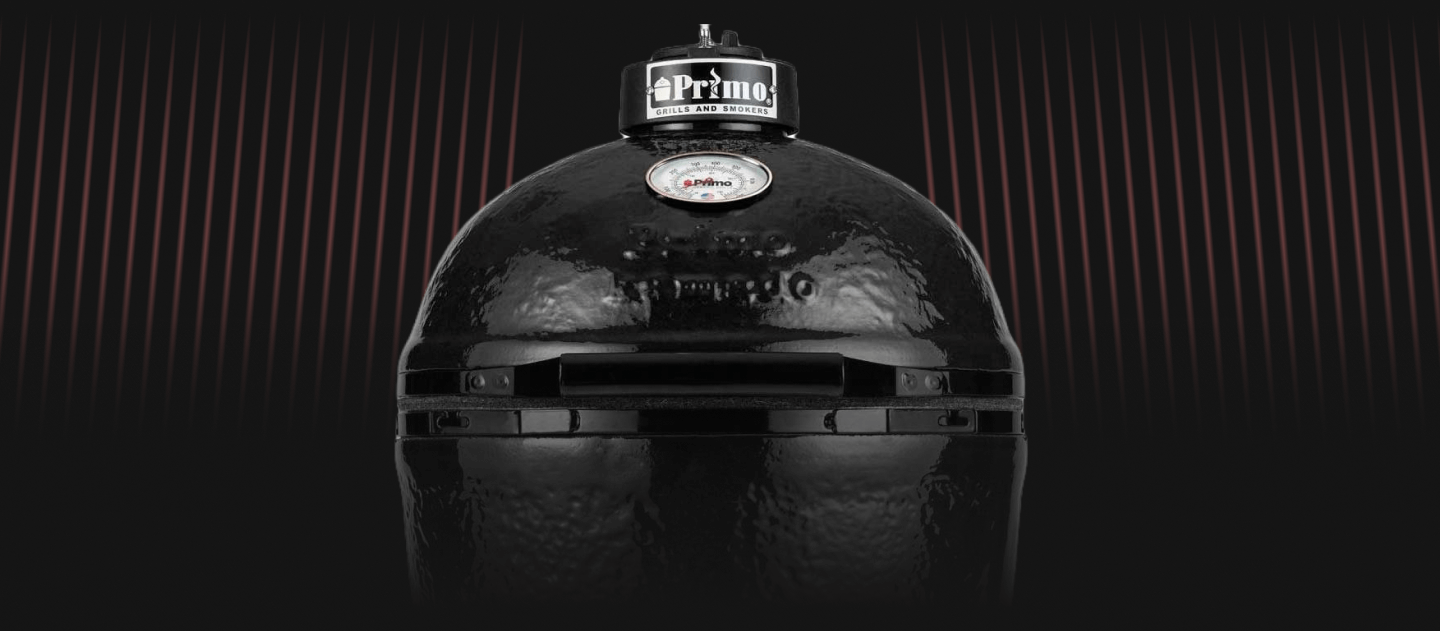
Outdoor grilling is a favorite American pastime for many people, and it can be a true hallmark of summertime. There’s something special about pulling the grill out and lighting it up, ready to sear, sizzle, and saute some delicious dishes that have a flame-grilled flavor that just can’t be imitated by other cooking methods.
To that end, there are many types of grills available for avid outdoor cooks, one of which is the Kamado Grill. Now, what is so great about a Kamado Grill? It’s a very unique type of grilling equipment, able to reach high temperatures quickly and maintain that temperature well.
A Kamado-style Grill is also made from ceramic or aluminum, which is one of the reasons it can maintain temperatures without fluctuating— the insulation offered by ceramics is a primary selling feature for these grills, not to mention the longevity of the product.
In fact, throughout recent years the outdoor Kamado Grill has enjoyed heightened popularity and is projected to remain a stylish choice for anyone looking to do some outdoor cooking.
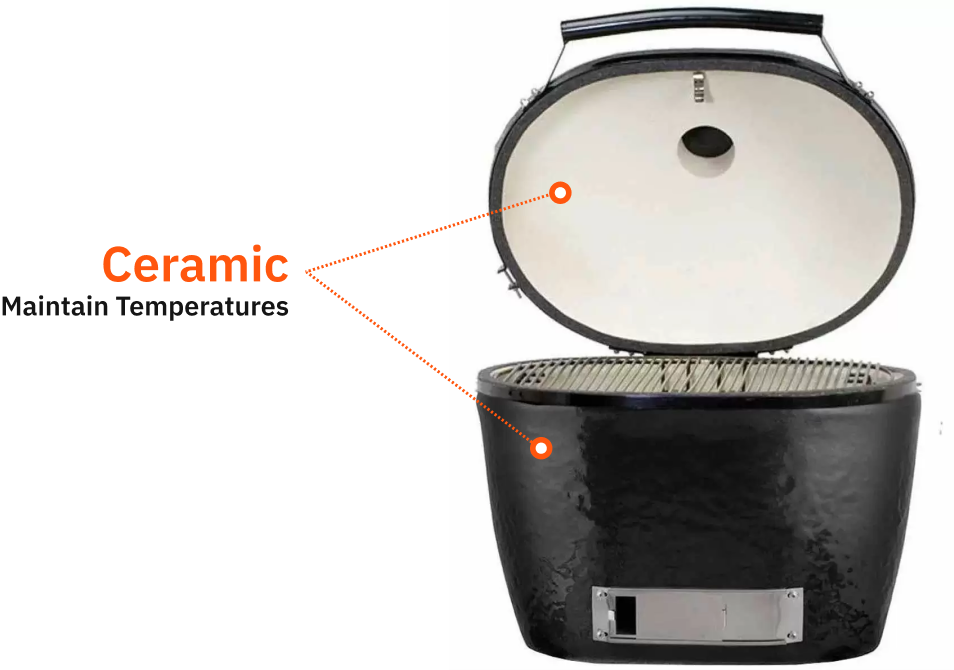
From backyard cookouts to street food trucks, the Kamado Grill continues to be the number one choice for many individuals and businesses, thanks to their excellent construction, unique cooking abilities, and how durable they are.

But that’s just scratching the surface of Kamado Grills. Read on for more information, including what makes a Kamado Ceramic Grill different from other types, its various parts, and how to best use it, among many other aspects. If you are looking for a deep dive into this special outdoor grill, then you are in the right place.
What is a
Kamado Grill?
The first thing you might notice about a Kamado Grill is its distinctive shape. Many people describe it as being egg-shaped, with a rounded lid and curving body. Additionally, this type of grill is made out of ceramics and is one of the most efficient cookers available.
But what exactly is a Kamado Grill? Let’s take a moment to discuss the particulars of what makes up a Kamado Grill and why it’s so different from other models.
Made From Clay
As mentioned, a Kamado BBQ Grill is a ceramic cooking unit. And while this might make it seem like a fragile piece of equipment at first glance, it’s actually one of the biggest advantages that a Kamado Grill has over other types of barbeques.
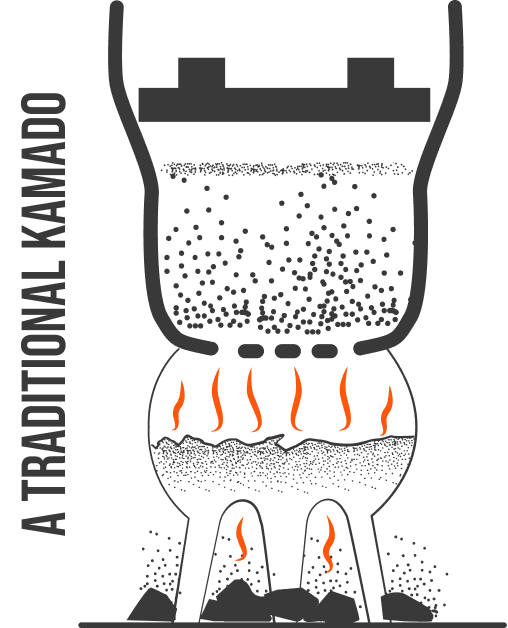
This use of ceramics and even the shape are reminiscent of ancient cooking methods that originated thousands of years ago, throughout Asia.
In particular, the word “kamado” itself refers to a stove or place where cooking takes place, and this type of grill has existed throughout Japan, Korea, and China for centuries.
The ceramic construction and shape of modern Kamado Grills are one of the reasons why they have continued to be so popular— because the ceramic material is a great thermal conductor, the rounded and insulated interior of the Kamado Grill can absorb much more heat than other types of grills that use aluminum or steel as their primary construction materials. Kamado grills can be purchased to be built-in to an outdoor kitchen, or freestanding to use anywhere outside. They are even available in smaller portable sizes to easily take on the go.
Plus, the distinctive egg shape makes the Kamado-style Grill better for keeping heat and moisture within the cooking space, leading to better-tasting and fresher food going directly from the grill to your table.
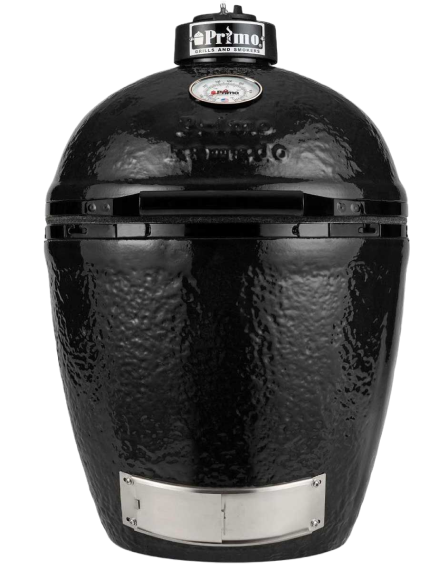
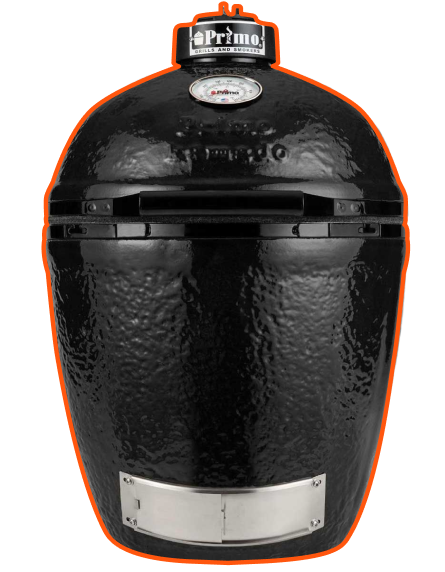
Uses Charcoal Or Wood As Heat
Because this type of grill is so effective at keeping the temperature regulated, a Kamado Grill is very fuel-efficient. And as that means you need to purchase less fuel that might go to waste with a less efficient grill, you might be able to save some money on it!
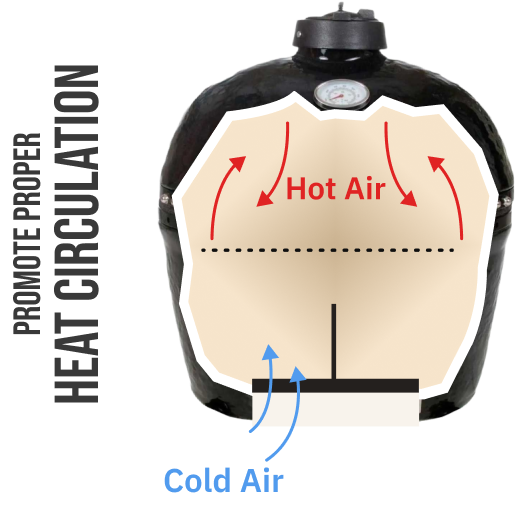
Plus, with the insulation and shape that promote proper heat circulation, your food cooks evenly and takes on a wonderful, smokey flavor, thanks to the charcoal or wood used to power the Kamado BBQ Grill.
Can Use Grill For Many Types Of Cooking
And speaking of cooking, one of the best selling features for why you should buy a Kamado Grill is its wide range of uses. Unlike other kitchen equipment that might only do one task, like a toaster or tea kettle, the Kamado Grill is incredibly versatile— from baking to grilling, roasting to smoking, it does it all.
Thanks to the different temperature levels circulated and controlled by the Kamado Grill’s unique design, the options are nearly endless for what you can create on the grill.
The highest temperatures allow for very hot searing, which is ideal for dishes like steak or burgers, able to produce that signature cross-hatching that grilled foods are known for.
Or, if you want to take advantage of the Kamado Grill’s option for a variety of indirect heat levels, you can roast a whole chicken or bake a pizza with the perfect temperature setting. There’s virtually no end to what you can cook on a Kamado Grill!
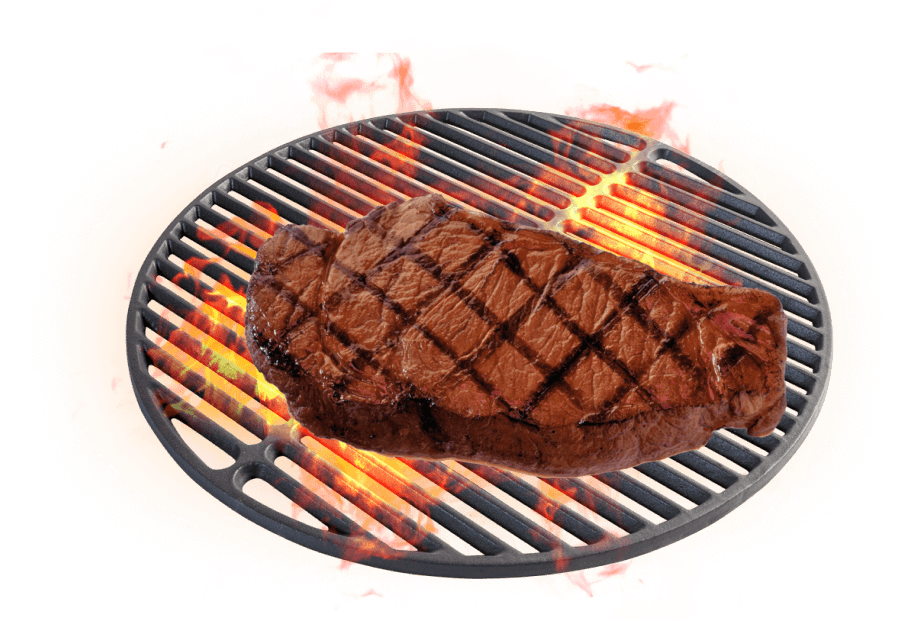
Parts Of A
Kamado Grill
In order to fully understand the allure of a Kamado Grill and how versatile its functions are, it’s important to find out about the parts that comprise it and what makes the best Kamado Grill exactly that.
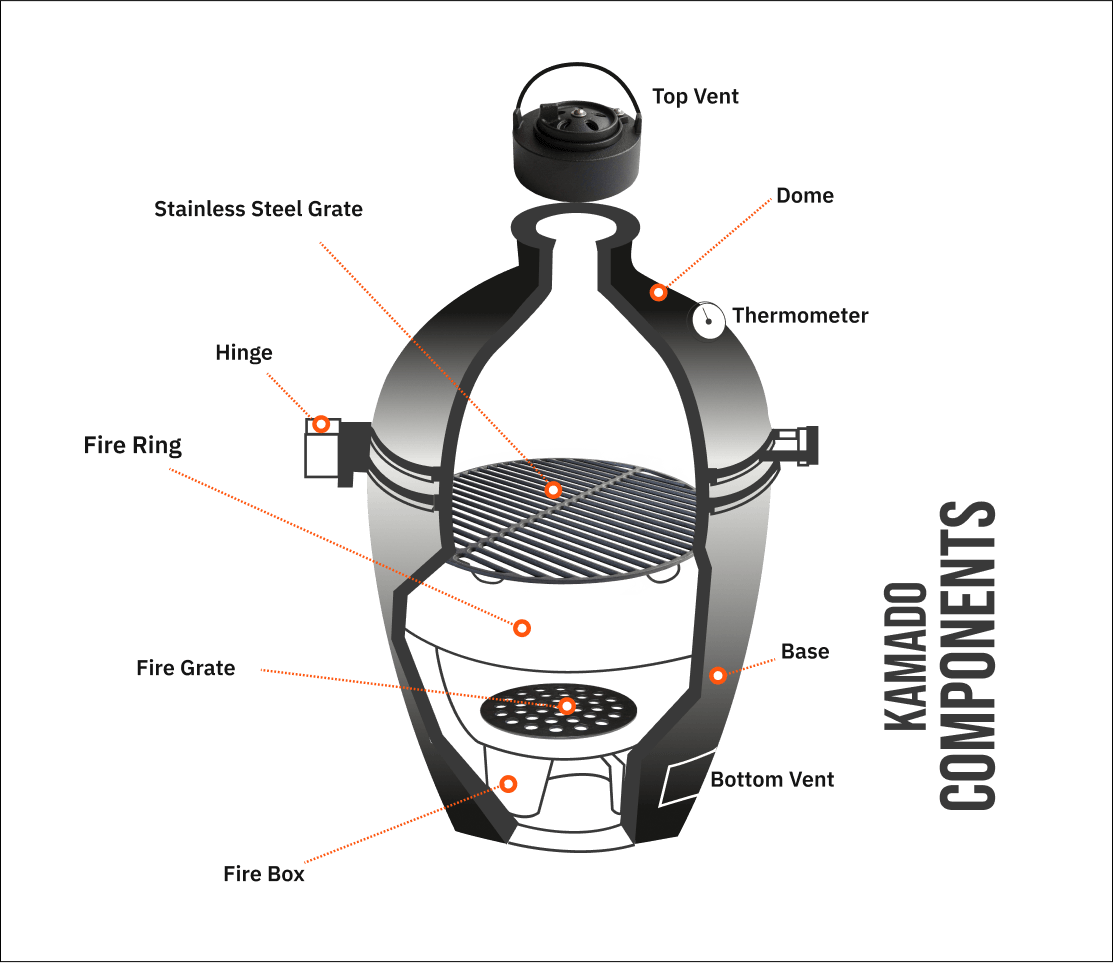
Top Vent
The Kamado Grill’s effectiveness depends on its airflow and how well the heat can circulate. This is governed by two primary vents on the top and bottom of the unit.
The top vent is located at the very pinnacle of a Kamado Grill and is generally made from aluminum, stainless steel, or iron for longevity. By controlling this vent via a daisy wheel-type device and how open it is, you can regulate the temperature within your grill.
Dome
Essentially the lid, the Kamado Grill dome retains the heat, smoke, and air necessary to cook whatever is inside. The position of the dome is important to consider when cooking different types of dishes— for example, when smoking meat, the dome should be kept closed to foster as much smoke as possible.
Because of its solid construction, the dome is typically quite heavy and uses a sturdy hinge to lever open and closed.
Thermometer
The temperature gauge or thermometer located near the top of the dome is a good indicator of how warm the interior of your Kamado Smoker Grill is getting.
However, do keep in mind that this thermometer does not give you the exact temperature level of the cooking surface itself, just the heat contained within the dome as a general guide.
Base
The base of your Kamado Grill contains all the parts that make it hot and smokey, so it’s an essential portion of the unit. You will find all the fuel and fire parts inside the lower half of the grill.
Bottom Vent
As previously mentioned, the vent system of a Kamado Grill is one of the key parts of what makes it reach the temperatures that it does and maintain them without fluctuation. Some models of Kamado Grills also call the bottom vent a draft door, but it functions the same regardless of the name.
Using the door attachment or flue on the bottom vent, and monitoring it to ensure it stays at the right openness, is important to get the Kamado Grill to the right temperature and keep it there. Plus, the air circulation allows for better moisture retention inside the grill for better food quality.
Firebox
This is the place where you put the fuel that makes the entire grill run! Whether you choose to use charcoal or wood as your fire source, this is the dish that safely contains it, complete with a slot for airflow from the bottom vent to reach the fuel and foster a better flame.
Fire Ring
Sitting directly atop the firebox, this is a unit that creates space between the fuel and the cooking grate itself. When refueling your Kamado Ceramic Grill, it’s important to only fill it up to the level of this fire ring to maintain the separation for better cooking.
Fire Grate
Complete with holes or slots inside it for ventilation, this holds your fuel (charcoal or wood) and is the piece at the bottom of the firebox. The slots are important for debris or parts of the fuel to crumble through as it burns away, and can be removed later.
Steel Grate
This is the surface that your food sits atop during cooking. It is essentially similar to any BBQ griddle surface and is most commonly made of stainless steel to prevent sticking or rust on the cooking grate. This surface is situated right above the firebox.
How Do Kamado Grills Work?
Now that we are more familiar with the various parts that make up a Kamado Grill, let’s take a moment to delve into the particular functions and what makes this type of grill work.
Because Kamado Grills are very different from other barbeque units, and often are a sizable investment due to their price tag, people can be naturally curious about what makes a Kamado Charcoal Grill so unique. And that’s exactly what you’re about to find out!
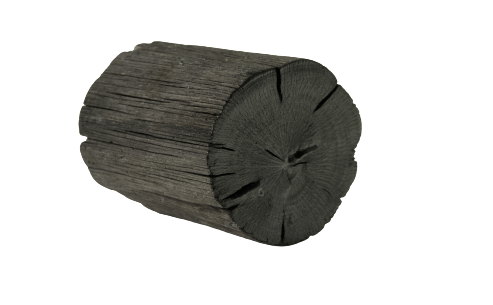
The first step to getting your grill on comes with fuel.
Charcoal or wood are the top choices for this type of unit and go into the firebox portion to keep it contained and aflame.
Then, airflow throughout the grill is modulated by the top and bottom vents, and can be changed by sliding the stopper wheels and allowing either more or less air in.
The reason for the importance of airflow is not only how hot your Kamado Grill gets on the inside, but also for keeping the fuel lit and properly oxygenated for the best cooking and grilling experience. In general, the wider you open the vents, the more air can flow inside, and the hotter your fuel will burn.
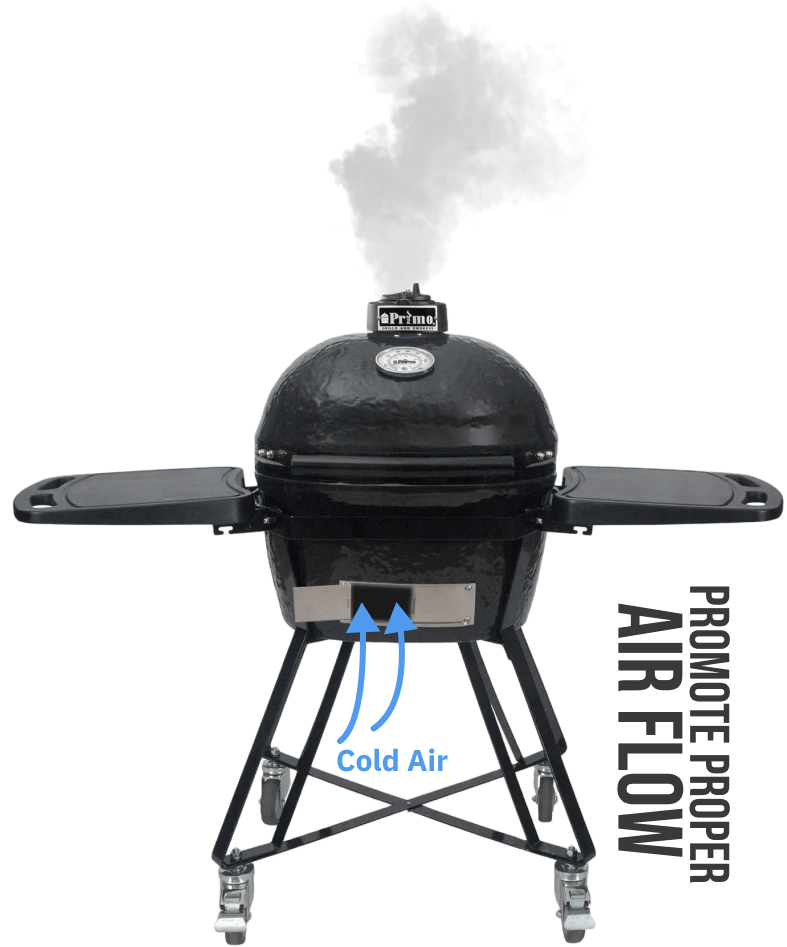
Once you close the dome lid on your Kamado Grill, the cooking process is incredibly stable and you don’t have to worry about losing heat or moisture, meaning that your fuel and time won’t go to waste.
From there, just adjust your interior temperature to fit the cooking process of the specific food— whether that be high heat for searing or low temperatures for baking— and wait for the magic to happen!
When not in use, make sure to close both the top vent and the bottom vent, and keep the dome lid securely shut. This prevents excessive amounts of natural debris or even outside critters from accumulating inside the Kamado Grill. And, when taken care of properly, you can expect your Kamado Smoker Grill to sit outside all year round, without needing a lot of maintenance.
How To Use Your
Kamado Grill
After reviewing the basic process of why a Kamado Grill works so well, it’s time to discuss how to use one and the best practices associated with grilling on a Kamado unit. And it all begins with selecting the right fuel source to power this incredible cooking implement!
Choosing Your Charcoal
(Lumpwood Charcoal Vs. Briquettes)
The flame needs to start somewhere in order to cook your food, so choosing a type of charcoal is the first step to firing up the Kamado Grill.
Depending on the type of charcoal you use, the food you produce will cook differently and hold alternating flavors, so considering all aspects of lumpwood charcoal versus briquettes is essential.
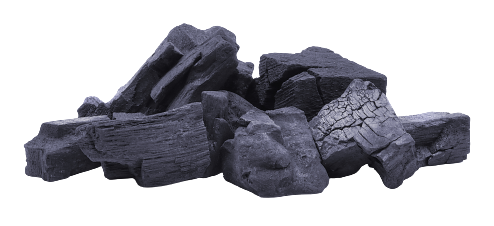
Lumpwood Charcoal
Made from hardwood sources, lump or lumpwood charcoal is many peoples’ top choice for grilling, particularly when it comes to using a Kamado Grill smoker.
The beauty of this type of charcoal is that everything beyond the carbon content of the original hardwood has been burned away and cooked off, leaving behind a form of pure charcoal that is all-natural and contains great flavor.
THE PROS
Some of the associated benefits of using lumpwood charcoal on your Kamado Smoker Grill include:
- Easy to light and stay lit.
- Minimal ash is left behind when finished burning, which makes for easier clean-up.
- The heat point of lumpwood charcoal is very high, meaning that you get an incredibly hot and clean burn throughout your grill.
THE CONS
However, there are also some disadvantages to working with lumpwood charcoal:
- Burning rates might be uneven due to the irregular shapes of each individual piece, leading to cooking time differences.
- The high burning rate also means that lumpwood charcoal doesn’t last as long for each use, making you purchase much more than other types.
Briquettes
On the other hand, charcoal briquettes have long been a popular fuel source for grilling and BBQs.
They are typically made up of a compound from charcoal, coal dust, peat, and sawdust, among other flammable materials.
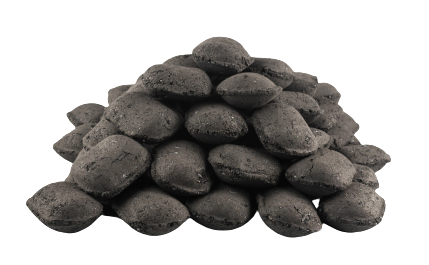
THE PROS
In the debate of which charcoal is the best, supporters of briquettes attest that:
- Burning at a lower temperature, you don’t need to refill your briquette fuel stores as often.
- Due to their more regular, man-made shapes, charcoal briquettes are more likely to burn at the same rate and maintain similar cooking times.
THE CONS
But briquettes are not all beneficial, including the following detractors from their use:
- Briquettes are more difficult to light than other fuel sources, which can lead to frustrated grillers who can’t get a spark to catch.
- They are also less natural, which impacts the flavor imparted to cooked food, as many people find briquette grills don’t produce the same taste.
Lighting The Kamado Grill
Beyond choosing the type of charcoal fuel for your Kamado Grill, how much charcoal you should use and configuring the coals are essential considerations.
How much charcoal to fuel the grill with depends highly on the temperature of your recipe and how long you will be keeping the grill on.
How much charcoal to fuel the grill with depends…

Temperature
highly on the temperature
of your recipe
Time to keep grill on
how long you will be
keeping the grill on

For example, if you are going to use the Kamado Grill for hot searing, use a good amount of fresh fuel and avoid reusing old coals. This is the same for low, slow cooking times, where fresh charcoal is also important— it burns better, more evenly, and much cleaner.
Arranging the coals below the steel cooking grate is also important, as the way you configure your fuel and heat source will ultimately determine how effective your cooking process is.
Many people start with a wide base and continue to place either lumpwood charcoal or briquettes until they form a small mountain shape. The pinnacle of which should be just below the slots inside the fire ring.
Place the largest pieces at the lowest point, as this will give you enough air flow from the bottom vent to properly oxygenate and feed the flames for as long as the cooking time requires.

After you get your fuel all set up, it’s time to light it. You can make the process easier by using a firestarter, an electric starter, or even the chimney starter method— which involves layering a metal cylinder with newspaper and charcoal, and relying on the natural flow of heat to help the fire get going.
A word to the wise, at this stage: do not use lighter fluid to get your fuel alight. Lighter fluid might make the fire happen faster, but it also can seep into the ceramic material of your Kamado Grill and affect the taste of cooked food, giving it an unpleasant chemical flavor.
Then, open up the vents to regulate the air flow and get your Kamado Grill on the way to the right temperature!
Hit Target Temperature
It’s wise to let your Kamado Grill heat up and arrive at its target temperature before adding food to the grill surface. That way, your cooking time will be accurate and the risk of undercooking food is mitigated.

To hit the right temperature…
20 or 30 minutes
50° F
After being lit for about 10 minutes, close the dome lid and slide the top vent into an open position. It should take a further 20 or 30 minutes for the Kamado Charcoal Grill to hit the right temperature, particularly if you are opting for a hot sear.
Once you are within 50°F of your heat goal, keep an eye on the lid thermometer and adjust the top vent to be about halfway open. This will help prevent the Kamado Grill from overshooting the target temperature!
Grilling Time
Once the grill gets hot enough, you can safely open it up again and add the ingredients to whatever dish is being prepared. Whether you are searing, baking, roasting, or steaming, your Kamado Grill Smoker can handle the task.
Just be patient with the initial heating process, and keep an eye on the temperature as it’s always easier to bump it up a couple of degrees within the convection process, but significantly harder to cool it down a small amount.
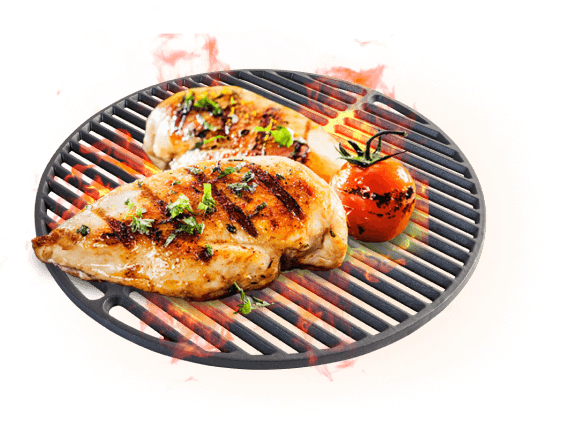
Pros Of Kamado Grills
Kamado Grills are certainly one of the greatest investments for outdoor cooking and mastering your overall grilling technique. Not only are they durable and low-maintenance, but the quality of the food produced by these grills is far superior.
Read on for more of the advantages that come with using a Kamado Grill yourself!
Cons Of Kamado Grills
However, there are some disadvantages to using a Kamado Grill, though, for most people who own this type of grill, the benefits do outweigh them. As an honest review of the downsides to Kamado Grills, read on to find out more.
Different Ways To
Cook On Your
Kamado Grill
Once you get your Kamado Grill up and running, there are a few ways you can use its heat convection and temperature circulation for cooking. These include direct heat and indirect heat at a variety of temperature points, and each will accomplish a different cooking task.
For Very Hot Searing (400-750°F)
When you crank up the heat and add the meat, that’s when the best searing action can happen. A Kamado Grill is great for cooking a variety of proteins, including steak cuts, burgers, fish, seafood, and much more, and is perfect for achieving charbroil marks on ingredients.
Check out these recipes for some grilling inspiration, including burgers, a whole grilled fish, and king prawns with garlic.
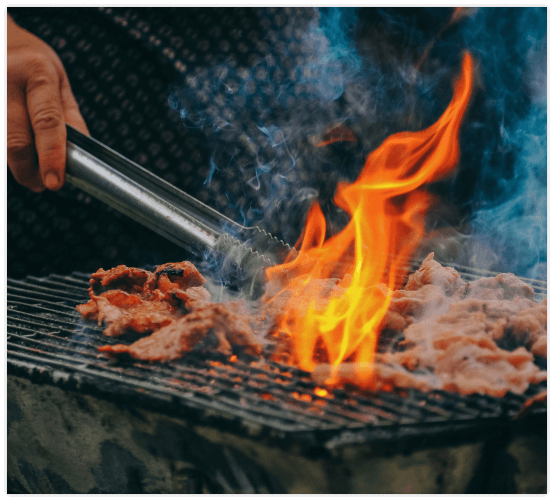
Low To Medium Indirect Heat (225-450°F) For Roasting And Smoking
By lowering the heat a bit and letting your Kamado Grill settle into a mid-range temperature, you can harness the flavor and cooking power of the smoke swirling around under the dome.
This is the perfect setting for smoking and slow-roasting a variety of meats, including more delicate types like chicken, ribs, pork butt, brisket, and beef joints.
You can find a range of low and slow recipes for racks of pork ribs, pulled pork shoulder, and succulent beef briskets.
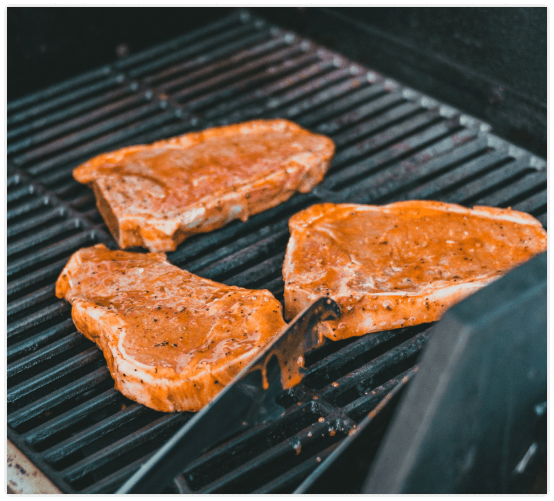
High Indirect Heat (500-750°F) For Baking
The last option involves turning the heat up again, but creating space to have the flame only indirectly cook the ingredients. That’s where you can test out some baking recipes, with the most popular choices including pizza, desserts, and even bread!
The key is to get your Kamado Grill’s temperature just right, but when you do, its convection capabilities are on full display with dishes like baked Camembert cheese, homemade bread, and apple pie.
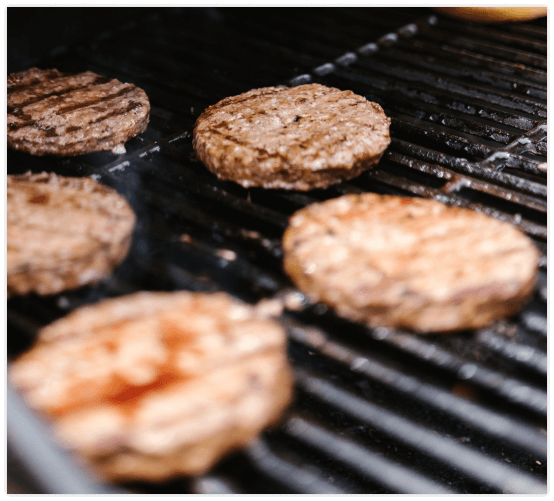
Tips For Using a
Kamado Grill
Though beginners to Kamado Grills will have a learning curve for how to be a successful griller, it’s definitely manageable. And to get you started, here are 7 top tips and tricks for how to use a Kamado Grill!
- Conserve Fuel
- Avoid Chemicals
- Use A Grease Catcher
- Put Sauces On Last
- Learn How The Air Vents Work
- Use Firestarters
- Try A Variety Of Fuel
Conserve Fuel
Try not to overload the charcoal— the fuel efficiency of a Kamado Grill means that less will go a long way.
And when you have finished grilling, simply shut the top and bottom vents and save the remaining charcoal for next time.
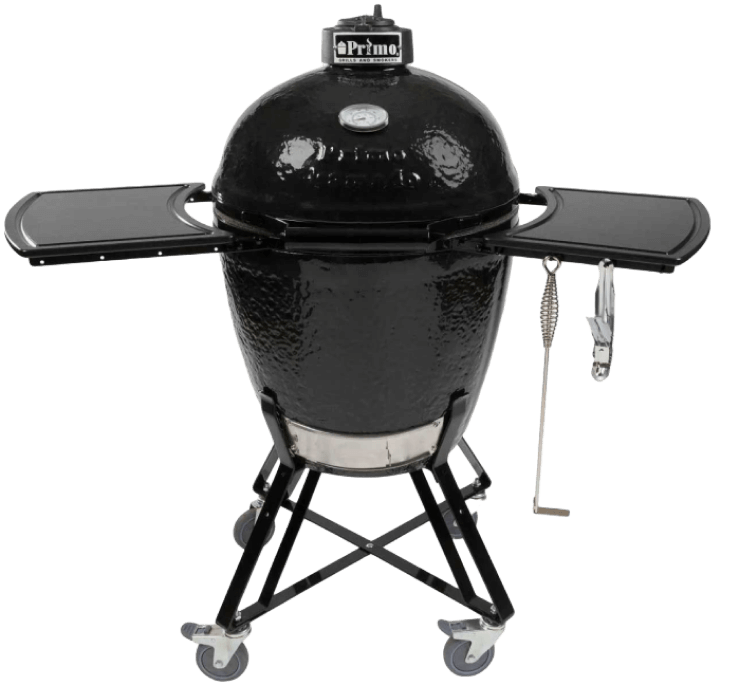
Avoid Chemicals
As previously mentioned, lighter fluid should not be used with a Kamado Grill, and the same goes for a variety of chemical-heavy cleaners.
Because the grill is made of ceramic materials, their porous nature can absorb chemicals and have long term effects on the food you grill.

Use A Grease Catcher
Make the already light clean-up process even easier by using a grease catcher under any grilling meat.
Not only does it lessen the amount of splatter, but it also helps prevent possibly dangerous grease flare-ups.

Put Sauces On Last
Don’t let your sauces, glazes, or marinades burn by putting them into the Kamado Grill too early
— instead, leave them until later and the grill has had a chance to cool slightly, and the sauces should set safely across the meat or vegetables.

Learn How The Air Vents Work
The key to regulating temperature inside a Kamado Grill is through air circulation,
so learning how to alternate and open the air vents on the top and bottom of the unit is essential.

Use Firestarters
Get your flames fired up quickly by tucking two or three firestarters into the initial charcoal pile within the firebox.
These will kick-start the process and won’t leave unpleasant chemical residues behind.

Try A Variety Of Fuel
Fuel types tie directly to flavor, so don’t be afraid to experiment with a variety of them!
From regular charcoal to lumpwood charcoal, flavor inserts to hardwood, you can get different tastes that help diversify your cooking.

Our
Kamado Grills
For anyone looking to buy a Kamado Grill, not only is it a great investment, but it will also change the way you cook and grill outdoors. And picking the best Kamado Grill is important, so the following models are some of the most popular with outdoor chefs just like you!
1. Primo Grills Large Round Ceramic Kamado Grill
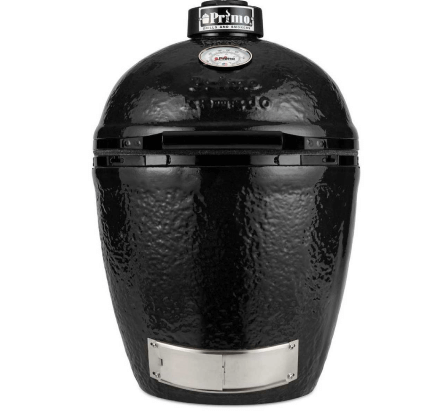
MODEL
771
COOKING GRID DIMENSIONS
18.5” Round
GRILLING SURFACE BTU
380 Square Inches
COOKING GRATE MATERIAL
Porcelain Coated Steel
Rely on this built-in, outdoor Kamado Grill for all your smoking, baking, searing, and roasting needs, and embrace the art of ceramic grilling.
https://grillio.com/primo-large-round-ceramic-kamado-charcoal-grill
2. Primo Grills Oval Junior Ceramic Kamado Grill On GO Portable Carrier
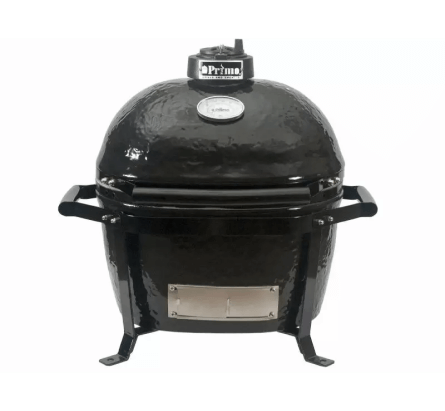
MODEL
774+321
COOKING GRID DIMENSIONS
18.5” x 13.5”
GRILLING SURFACE BTU
210 Square Inches
COOKING GRATE MATERIAL
Porcelain Coated Steel
For the griller on the go, this portable Kamado Grill is the perfect size to pack up and take to the beach, the woods, or a friend’s house to whip up a wonderful, flame-cooked meal.
https://grillio.com/bbq-grills-smokers/kamado-grills/portable-kamado-grills
Conclusion
In all, a Kamado Grill is one of the best choices you can make when it comes to the type of grill that will last for years, require low maintenance tasks, and produce outstanding meals.
Though some models can be quite expensive, users of the Kamado Ceramic Grill tend to swear by these units, and haven’t looked back since their purchase! For anyone serious about outdoor grilling, and who wants one of the most effective grills on the market with incredible durability and mealtime results, the Kamado Grill might be right for you.
Key Questions
- What is a kamado grill?
- How are kamado grills representative of some ancient cooking methods?
- What properties of kamado grills make them great for cooking?
- What are the parts of a kamado grill?
- How do kamado grills work?
- How to use a kamado grill?
- What are the different types of charcoal you can use for grilling?
- What are the pros of using a kamado grill?
- What are the cons of using a kamado grill?
- What are the different ways to cook on a kamado grill?
- What are some useful tips for cooking on a kamado grill?
- What are some examples of different kamado grills?